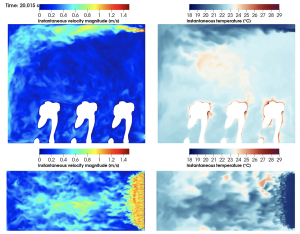Healthcare
With the spread of airborne pathogens, where you sit when using mass transit matters
16 February, 2022 | Written by: Robert Manson-Sawko, Carlos Peña-Monferrer, and Samuel Antão
Categorized: Healthcare
Share this post:
New research into how aerosols move through the air could help reduce the spread of diseases, such as COVID-19, providing insights into the ventilation requirements of public transport, healthcare facilities, and workplaces.
On a regular day, whether you’re at home, at work, or out socializing, it’s highly likely that you’ll come face-to-face with someone else at some point during the day.
This used to be an unremarkable fact of life. But in the COVID-19 world we now live in, coming into contact with others is something that has to be considered by anyone responsible for the design or management of spaces that we share. Our health and safety increasingly depend on understanding airborne transmission of diseases and the controls we can introduce to restrict them.
The fundamental roles played by a range of environmental elements — temperature, air flow, humidity, among others — have been investigated for decades. However, the ongoing nature of the pandemic means there is a need for a more in-depth understanding of exactly how aerosols move through the air. Our latest research,1 published in the journal Physics of Fluids, provides insight in this area.
Does coughing, sneezing or even speaking spread disease?
The movement of droplets released from a person’s nose or mouth, by sneezing and coughing, or just talking, has been investigated using practical and theoretical approaches. This research generally focused on conventional building systems, such as mixed and displacement ventilation, among others.
However, perhaps the time when we’re most likely to be exposed to the greatest concentration of people is when using public transport on our daily commute, or when flying, a part of life that often means we’re densely packed with our fellow passengers.
As such, we studied the conditions of asymptomatic airborne transmission in mass transportation. Our background and expertise in the mathematical modelling of bubbles and droplets led us to believe we could contribute to the understanding of how virus transmission happens. More importantly, we hoped to gain insights into some big questions, such as whether exhaled droplets evolve in a ventilated space, and if the ventilation systems used in public transportation safe and can be improved to help mitigate disease transmission.

Caption: Schematic representation of the domain including dimensions and patch labels (units in mm).
There are no simple answers to these questions but by using open-source computational fluid dynamics software from OpenFOAM, and data on respiratory flows representative of speech from OPENGLOT, we developed a novel, comprehensive, numerical model to improve the understanding of these systems and make them safer.
Building the aerosol-exhalation model
Our work focused on investigating speech-related exhalations in public transport — a less understood scenario but more characteristic of asymptomatic transmission. We first created a simulation, with high spatial and temporal resolutions, that represented a trio of passengers sitting in a row within a larger occupied space. We then investigated three scenarios: exhalation from the aisle, middle, and window seat positions.

Caption: Instantaneous velocity magnitude and temperature for front (x ¼ 0.456 m) and top (y ¼ 1.515 m) views for the window scenario.
Using a high-performance computing (HPC) facility equipped with IBM processors, we analyzed what happens when speech droplets are exhaled from each of the three passengers in a ventilated space, like those found in public transport. Simulating the air flows from a realistic ventilation system inlet, where air is injected at the top and extracted at the bottom side, generated an internal recirculation for enhancing thermal comfort and removing contaminants — but it also created some unfavorable effects.
Our results showed that a ventilation systems performed quite well overall. The aerosols’ distribution revealed that higher concentrations were less prevalent along the center of the modeled space where the passengers sit. However, we observed contamination across rows, which is undesirable for containing the risk of infection in a given row, but has the benefit of diluting the concentration of infectious droplets throughout the entirety of the modeled space.
Finding the best seat
The computer model showed that droplets from the window seat passenger move more vertically than the other positions, and as a result invade the space of other passengers to the least extent (among the three seats). In contrast, droplets released from the middle seat invade the aisle passenger’s space, which could increase the risk of infection. Droplets released from the aisle were immediately dragged down by the ventilation system. What became clear, however, were the complex interactions between body plumes (rising air from body heat), exhalation, and ventilation.
These interactions are made even more complex as some forms of public transport are equipped with personal ventilation systems, such as overhead air blowers. Our research indicates that a downward flow caused by the passenger in the middle seat might be more likely to have a negative effect for that passenger, as overhead aerosols will be moved down to their breathing region.
Breathe a sigh of relief — in any space
The models and processes used in our research focused on public transportation vehicles, but the investigation could extend to commercial or residential buildings, healthcare facilities, offices, schools and a wide range of manufacturing plants. Modelling the exhaled droplets and the movement of aerosols in any of these environments could help in the design of ventilation systems to reduce the spread of contaminants, infections, and pollutants.
Fundamentally, this work developed a highly detailed method to simulate and analyze indoor air contamination in any given space, beyond the context of the pandemic. In a world where “healthy environments” are increasing in demand, these insights will prove invaluable for a place we can all breathe a sigh of relief.

Research in computational modelling and high performance computing


Streamlining Life Sciences Research: Simplifying Data Access with Design Principles
Life Sciences research and development is complicated: complex tasks are carried out in an environment of big data, specialised technology and regulated processes. The challenges of this complexity risks making processes and interactions iterative, slow and expensive. To accelerate innovation in the development of safe and effective treatments, Life Sciences organisations need to cut through these challenges […]
